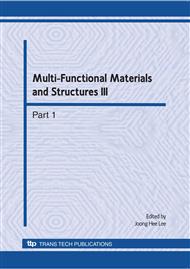p.1239
p.1243
p.1247
p.1251
p.1255
p.1259
p.1263
p.1267
p.1271
Preparation and Corrosion Protection Effect of Electroactive Polyurethane Containing Amino-Capped Aniline Trimer
Abstract:
Electroactive polyurethane (EPU) containing conjugated segments of electroactive amino-capped aniline trimer (ACAT) has been successfully synthesized and characterized through Fourier-Transformation infrared and UV–visible absorption spectroscopy. Subsequently, electroactivity (i.e., redox capability) of as-prepared EPU was investigated by electrochemical cyclic voltammetry (CV) studies. It was noticed that the as-prepared EPU exhibited reversible redox capability was found to reveal better corrosion protection effect on cold-rolled steel (CRS) electrodes than that of non-electroactive polyurethane based on a series of electrochemical measurements such as corrosion potential, polarization resistance, corrosion current and electrochemical impedance spectroscopy (EIS) studies in 5 wt-% NaCl electrolyte. This significant enhancement of corrosion protection on CRS electrodes as compared to non-electroactive polyurethane might be probably ascribed to the redox catalytic property of as-prepared EPU coatings inducing the formation of passive layer of metal oxide, as evidenced by the SEM and ESCA studies.
Info:
Periodical:
Pages:
1255-1258
Citation:
Online since:
August 2010
Authors:
Keywords:
Price:
Сopyright:
© 2010 Trans Tech Publications Ltd. All Rights Reserved
Share:
Citation:


